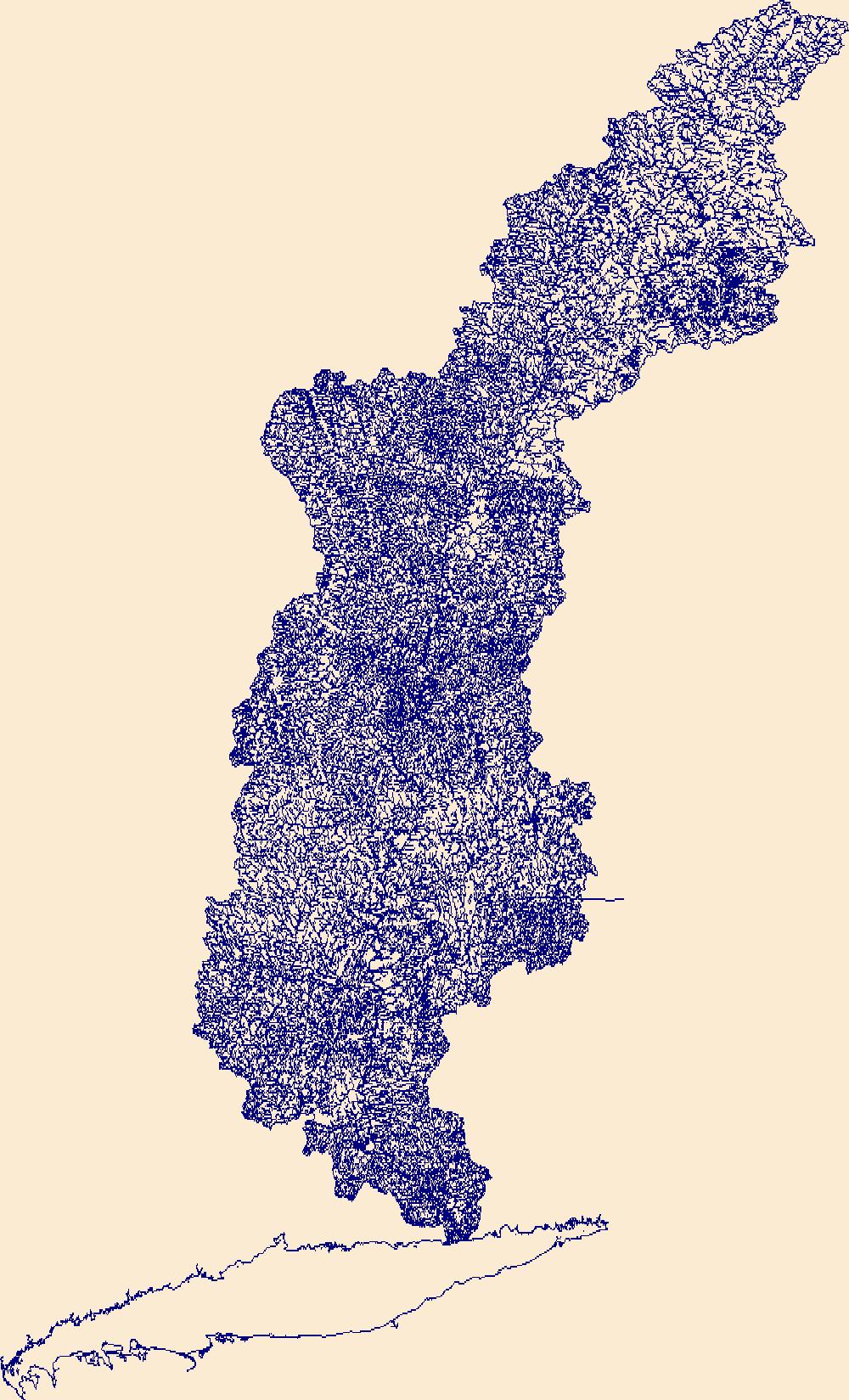Filters: Tags: Water Resources (X) > Date Range: {"choice":"month"} (X)
176 results (12ms)|
Filters
|
This data release contains monthly 270-meter resolution Basin Characterization Model (BCMv8) climate and hydrologic variables for Localized Constructed Analog (LOCA; Pierce et al., 2014)-downscaled ACCESS 1.0 Global Climate Model (GCM) for Representative Concentration Pathway (RCP) 4.5 (medium-low emissions) and 8.5 (high emissions) for hydrologic California. The LOCA climate scenarios span water years 1950 to 2099 with greenhouse-gas forcings beginning in 2006. The LOCA downscaling method has been shown to produce better estimates of extreme events and reduces the common downscaling problem of too many low-precipitation days (Pierce et al., 2014). Ten GCMs were selected from the full ensemble of models from the...
During the spring and summer of 2022, the U.S. Geological Survey collected water-quality samples for nutrient analysis at 45 stations across the state of Connecticut and adjacent areas of New York and Rhode Island to better understand the groundwater discharge component of nitrogen loading to the Long Island Sound. The targeted stations were located in small drainage basins (less than 50 square kilometers) in the southern portion of the Long Island Sound watershed. Sites were selected randomly from groups based on expected drivers or controls on baseflow nitrogen loads. Factors used in the grouping included four metrics calculated for the upstream watershed: percent impervious cover, septic system density, percent...
Categories: Data;
Types: Downloadable,
Map Service,
OGC WFS Layer,
OGC WMS Layer,
Shapefile;
Tags: Connecticut,
Connecticut Coastal,
Hydrology,
Long Island Sound,
New York,
These data were compiled to provide a resource for other researchers interested in water-surface elevations and flow velocity across a wide range of discharge in the study reach for the project. Objective(s) of our study were to construct a two-dimensional hydrodynamic model for the 15.8 mile tailwater reach of the Colorado River in Glen Canyon between Glen Canyon Dam and Lees Ferry, Arizona. These data represent the results of the two-dimensional modeling effort with each data table (50) including the results of each run of the model. Additionally, other data represent a comparison of modeled water surface elevations to measured water surface elevations for historic Bureau of Reclamation cross sections in the study...
This data release contains time-lapse imagery taken at U.S. Geological Survey (USGS) stream gaging stations with associated hydrologic and meteorological data related to each image. These data are to help improve the development of models in detecting water elevation at a given stream gaging station. Images of the water surface and surroundings at USGS stream gaging stations were taken at varying time intervals ranging between every five minutes to an hour. Cameras used include trail cameras, web cameras, and the custom river imagery sensing (RISE) camera. Time-lapse images for each USGS stream gaging station are provided in compressed files (file extension .7z). These files are named in a format to identify the...
Categories: Data;
Types: Map Service,
OGC WFS Layer,
OGC WMS Layer,
OGC WMS Service;
Tags: Remote Sensing,
USGS Science Data Catalog (SDC),
Water Resources,
camera,
image,
A total of 27 temperature sensors were deployed along the lower 90 miles of the Yakima River at 7 locations where cold water had been previously observed. These 7 cold-water areas had 3 to 6 temperature sensors installed to document the extent and duration of these cold-water areas and their impacts on mainstem temperatures of the Lower Yakima River. Cold-water areas included the mouths of tributaries, alongside channels, and within alcoves. Sensor deployments ranged from 1 to 2 years beginning in October 2018. All temperature data are included in the Yakima.temperatures.zip folder. Details of each monitoring location are provided in the site.locs.csv file. In addition to the raw data and site location information,...
Categories: Data;
Types: Map Service,
OGC WFS Layer,
OGC WMS Layer,
OGC WMS Service;
Tags: Aquatic Biology,
Benton County,
Ecology,
Hydrology,
Richland, WA,
These data represent total vegetation and surface water along approximately 12 kilometers of the Paria River upstream from the confluence of the Colorado River at Lees Ferry, Arizona. They are derived from airborne, multispectral imagery obtained in late May 2009, 2013, and 2021, collected with a push-broom sensor with 4 spectral bands depicting Blue, Green, Red and Near-Infrared wavelengths at a spatial resolution of 20 centimeters. The vegetation classification data were created using a supervised classification algorithm provided by Harris Geospatial in ENVI version 5.6.3 (Exelis Visual Information Solutions, Boulder, Colorado). The water data were created using a Green Normalized Difference Vegetation Index...
A before-and-after study design was used to examine effects of changes in cattle grazing practices on channel stability in Muddy Creek, an arroyo in the Colorado River headwaters. The changes in grazing practices were abrupt and focused on keeping cattle out of the riparian zone and increasing herd movement. We digitized 620 meander loop cutoff geometries within the digitized alluvial valley bottom of Muddy Creek and used the meander loop cutoff rate as a broad measure of channel stability. Poisson regression modeling of meander loop cutoff rate indicated that the change in grazing practices caused an order-of-magnitude decline in meander loop cutoff rate that was independent of other hydroclimatic and human-caused...
A three-dimensional groundwater flow model using MODFLOW-NWT was developed to evaluate historical and potential stream capture in the lower Humboldt River Basin, Nevada. The Humboldt River Basin is the only river basin that is contained entirely within the state of Nevada. The effect of groundwater pumping on the Humboldt River is not well understood. Tools are needed to determine stream capture and manage groundwater pumping in the Humboldt River Basin. Previous work has demonstrated that the river’s surface-water resource is sensitive to groundwater withdrawals, which have steadily increased since the 1950s for agriculture, municipal, and mining uses. A numerical groundwater flow model was developed for the purpose...
Categories: Data Release - Revised;
Types: Map Service,
OGC WFS Layer,
OGC WMS Layer,
OGC WMS Service;
Tags: Capture,
Groundwater Model,
Humboldt River Basin watershed,
Hydrology,
InlandWaters,
This data release contains monthly 270-meter resolution Basin Characterization Model (BCMv8) climate and hydrologic variables for Localized Constructed Analog (LOCA; Pierce et al., 2014)-downscaled Global Climate Models (GCMs) for Representative Concentration Pathway (RCP) 4.5 (medium-low emissions) and 8.5 (high emissions) for hydrologic California. The 20 future climate scenarios consist of ten GCMs with RCP 4.5 and 8.5 each: ACCESS 1.0, CanESM2, CCSM4, CESM1-BGC, CMCC-CMS, CNRM-CM5, GFDL-CM3, HadGEM2-CC, HadGEM2-ES, and MIROC5. The LOCA climate scenarios span water years 1950 to 2099 with greenhouse-gas forcings beginning in 2006. The LOCA downscaling method has been shown to produce better estimates of extreme...
These data were compiled for/to modeling efforts for U.S. Bureau of Reclamation National Environmental Policy Act (NEPA) analyses for the Colorado River in Grand Canyon, Arizona. Objective(s) of our study were to create revised monthly Lake Powell elevations and outflows from Bureau of Reclamation Colorado River Mid-term Modeling System (CRMMS) traces that incorporate the alternatives in the sEIS documents and indicate when potential actions may occur and how that changes water movement and storage. These data represent monthly hydrologies for Lake Powell: inflow, outflow, and elevation forecasts for 2024-2027, as well as volumes of water in outflows for different water mangement strategies in NEPA supplemental...

The High Resolution National Hydrography Dataset Plus (NHDPlus HR) is an integrated set of geospatial data layers, including the National Hydrography Dataset (NHD), National Watershed Boundary Dataset (WBD), and 3D Elevation Program Digital Elevation Model (3DEP DEM). The NHDPlus HR combines the NHD, 3DEP DEMs, and WBD to a data suite that includes the NHD stream network with linear referencing functionality, the WBD hydrologic units, elevation-derived catchment areas for each stream segment, "value added attributes" (VAAs), and other features that enhance hydrologic data analysis and routing.
In a study conducted by the U.S. Geological Survey (USGS) and the New Hampshire Department of Environmental Services, detectable concentrations of per- and polyfluoroalkyl substances (PFAS) were found in the soil at every site despite targeting locations with no known PFAS sources (Santangelo and others, 2022). The widespread distribution of PFAS concentrations in New Hampshire has since sparked critical interest into understanding whether recharge to groundwater contains significant concentrations of PFAS after infiltration through soils. To address this concern, the USGS implemented a pilot study designed to evaluate whether PFAS infiltrate through shallow soil into shallow groundwater. Five sites were selected...
Categories: Data;
Tags: Eastern United States,
Environmental Health,
Hydrology,
New Hampshire,
Northeast,
These data were compiled for Cabeza Prieta National Wildlife Refuge (CPNWR) in southern Arizona, to support managment efforts of water resources and wildlife conservation. Objective(s) of our study were to 1) measure water storage capacity at select stage heights in three tanks (also termed tinajas), 2) build a stage storage model to help CPNWR staff accurately estimate water volumes throughout the year, and 3) collect topographic data adjacent to the tanks as a means to help connect these survey data to past or future work. These data represent high-resolution (sub-meter) ground based lidar measurements used to meet these objectives and are provided as: processed lidar files (point clouds), rasters (digital elevation...
This data set contains shoreline rate of change statistics for New York State coastal wetlands. Analysis was performed using the Digital Shoreline Analysis System (DSAS), created by U.S. Geological Survey, version 5.0, an extension for ArcMap. A reference baseline was used as the originating point for orthogonal transects cast by the DSAS software. The transects intersect each polyline vector shoreline establishing intersection measurement points, which were then used to calculate the rates of change. End-point rates, calculated by dividing the distance of shoreline movement by the time elapsed between the oldest and the most recent shoreline, were generated for wetlands where fewer than three historic shorelines...
Categories: Data;
Types: ArcGIS REST Map Service,
ArcGIS Service Definition,
Downloadable,
Map Service;
Tags: Digital Shoreline Analysis System,
End-Point Rate,
Geography,
Geomorphology,
Great South Bay,

The High Resolution National Hydrography Dataset Plus (NHDPlus HR) is an integrated set of geospatial data layers, including the National Hydrography Dataset (NHD), National Watershed Boundary Dataset (WBD), and 3D Elevation Program Digital Elevation Model (3DEP DEM). The NHDPlus HR combines the NHD, 3DEP DEMs, and WBD to a data suite that includes the NHD stream network with linear referencing functionality, the WBD hydrologic units, elevation-derived catchment areas for each stream segment, "value added attributes" (VAAs), and other features that enhance hydrologic data analysis and routing.

The High Resolution National Hydrography Dataset Plus (NHDPlus HR) is an integrated set of geospatial data layers, including the National Hydrography Dataset (NHD), National Watershed Boundary Dataset (WBD), and 3D Elevation Program Digital Elevation Model (3DEP DEM). The NHDPlus HR combines the NHD, 3DEP DEMs, and WBD to a data suite that includes the NHD stream network with linear referencing functionality, the WBD hydrologic units, elevation-derived catchment areas for each stream segment, "value added attributes" (VAAs), and other features that enhance hydrologic data analysis and routing.
The data release consists of two companion air and water temperature datasets collected as part of the U.S. Geological Survey (USGS) Next Generation Water Observing System (NGWOS) program with data from both the Little Lehigh and White Clay Creek Watersheds in the Delaware River Basin. Data consists of 15-minute temperature data during the 7/2021 – 12/2022 study period for 21 air and 49 water locations (which include 6 continuous monitoring USGS streamgages) in the Little Lehigh Creek watershed and 8/2021 – 1/2023 for 28 air and 36 surface water locations (including 6 continuous monitoring USGS streamgages) in the White Clay Creek watershed. Datalogger installation locations for surface water locations were targeted...
Categories: Data;
Tags: Air Temperature,
Continuous Data,
Delaware River Basin,
Hydrology,
Pennsylvania,
Model Inputs: Midwest Climate Change Vulnerability Assessment for the U.S. Fish and Wildlife Service
This data release contains the climate change model inputs and Soil and Water Assessment Tool (SWAT) model outputs from 360 HUC-8 watersheds in the Midwest United States (Illinois, Indiana, Iowa, Michigan, Minnesota, Ohio, and Wisconsin), that were generated using the HAWQS (Hydrologic and Water Quality System) platform (https://hawqs.tamu.edu). The summarized data for a watershed-based climate change vulnerability assessment for U.S. Fish and Wildlife Service is also provided, along with the R code used to summarize the raw outputs. Watershed-based Midwest Climate Change Vulnerability Assessment Tool: https://rconnect.usgs.gov/CC_Vulnerabi
Per- and polyfluoroalkyl substances (PFAS) and related chemical and physical data are presented from 100 shallow soil sampling locations within the State of New Hampshire. Sites were randomly determined through an equal-area grid approach (Scott, 1990) targeting undisturbed areas, which included lands classified by the 2016 National Land Cover Database (Dewitz, 2019) as forested, shrubland, scrubland, grassland, herbaceous, wetlands, or barren land. Sampling sites were located at the closest point to the random location identified, where access and permission were available. To limit the potential for sampling results to be influenced by local releases of PFAS, a 500-meter buffer around parcels associated with known...
Categories: Data;
Tags: Environmental Health,
New Hampshire,
PFAS,
Soil Sciences,
USGS Science Data Catalog (SDC),
Resource managers and users seek information that can be used to balance the needs of competing uses of groundwater and streamflow in the Heeia watershed, Oahu. A previously constructed steady-state numerical groundwater-flow model for the island of Oahu, Hawaii (https://doi.org/10.3133/sir20205126) using MODFLOW-2005 with the Seawater Intrusion (SWI2) package was used to examine the effects of withdrawals in the watershed. Four simulations representing a baseline and various withdrawal conditions were run using the previously published numerical model. The baseline simulation represents conditions in 2001-10 which were used to calibrate the Oahu model and to which all other scenarios are compared. The three scenarios...
Types: Map Service,
OGC WFS Layer,
OGC WMS Layer,
OGC WMS Service;
Tags: Groundwater Model,
Hawaiian Islands,
Hydrology,
MODFLOW-2005,
Oahu,
|

|